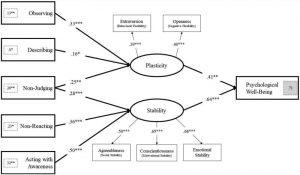Improve Caregiver Psychological Health by Changing the Brain Response with Mindfulness
By John M. de Castro, Ph.D.
“We are set up for short-term stress, but caregiving is long-term stress. Mindfulness is basically coming back into the present moment, so it works to inhibit the stress response. Most of us run around listening to our thoughts, and this is particularly true of caregivers, who are driven by the to-do list. They are never at rest.” – Joan Griffiths Vega
Dementia is a progressive loss of mental function produced by degenerative diseases of the brain. Dementia patients require caregiving particularly in the later stages of the disease. Caregiving for dementia patients is a daunting intense experience that can go on for four to eight years with increasing responsibilities as the loved one deteriorates. This places tremendous psychological and financial stress on the caregiver. Hence, there is a need to both care for the dementia patients and also for the caregivers. Mindfulness practice for caregivers has been shown to help them cope with the physical and psychological demands of caregiving. In addition, mindfulness training has been found to help protect aging individuals from physical and cognitive declines.
The nervous system is a dynamic entity, constantly changing and adapting to the environment. It will change size, activity, and connectivity in response to experience. These changes in the brain are called neuroplasticity. Over the last decade neuroscience has been studying the effects of contemplative practices on the brain and has identified neuroplastic changes in widespread area. and have found that meditation practice appears to mold and change the brain, producing psychological, physical, and spiritual benefits.
In today’s Research News article “Grief, Mindfulness and Neural Predictors of Improvement in Family Dementia Caregivers.” (See summary below or view the full text of the study at: https://www.ncbi.nlm.nih.gov/pmc/articles/PMC6530345/), Jain and colleagues recruited dementia caregivers (91% female) and provided for them either 4 weeks of mindfulness training or 4 weeks of relaxation training. Training occurred in a once a week meeting along with home practice. The participants were measured before and after training for grief, depression, and mindfulness. They then had brain scans performed with functional Magnetic Resonance Imaging (fMRI) while they viewed pictures of their loved one with dementia or a stranger with the pictures labelled with either grief related words, e.g. disease, dementia, and sick or with neutral words e.g. village, planter and curve.
They found that at baseline grief and depression levels were high and strongly related. They also found that the higher the levels of mindfulness the lower the levels of grief and depression. After mindfulness training there were reductions in grief and depression and increases in mindfulness. These findings are similar to previous research of improvements in the mental health of caregivers after mindfulness training.
Interestingly, in comparison to pictures of strangers, when showed pictures of their loved ones with dementia the caregivers showed increases in brain activation in the dorsal anterior cingulate gyrus and precuneus. Viewing grief related words results in increased activity in the medial prefrontal cortex. The greater the decreases in grief following training the greater the activation of the medial prefrontal cortex and precuneus.
The structures showing activation to the caregiver’s loved one all are components of what is called the default mode network which is involved in self-referential thinking and thinking about others. It would appear that the mindfulness training resulted in greater thinking about the dementia patient and the self when viewing a picture of the patient. This may be reflective of heightened compassion for the self and the patient. This in turn, may produce improvements in the caregivers mental health.
So, improve caregiver psychological health by changing the brain response with mindfulness.
CMCS – Center for Mindfulness and Contemplative Studies
This and other Contemplative Studies posts are also available on Google+ https://plus.google.com/106784388191201299496/posts and on Twitter @MindfulResearch
“By focusing on the fact that families and communities are producers of health and health care, not just clients or consumers, it empowers families and communities to co-create health interventions,” – Alicia Bazzano
Study Summary
Jain, F. A., Connolly, C. G., Moore, L. C., Leuchter, A. F., Abrams, M., Ben-Yelles, R. W., … Iacoboni, M. (2019). Grief, Mindfulness and Neural Predictors of Improvement in Family Dementia Caregivers. Frontiers in human neuroscience, 13, 155. doi:10.3389/fnhum.2019.00155
Abstract
Background: Family dementia caregivers often suffer from an immense toll of grief while caring for their loved ones. We sought to identify the clinical relationship between grief, depression and mindfulness and identify neural predictors of symptomatology and improvement.
Methods: Twenty three family dementia caregivers were assessed at baseline for grief, mindfulness and depression, of which 17 underwent functional magnetic resonance imaging (fMRI). During fMRI, caregivers were shown faces of either their dementia-stricken relative or that of a stranger, paired with grief-related or neutral words. In nine subjects, post fMRI scans were also obtained after 4 weeks of either guided imagery or relaxation. Robust regression was used to predict changes in symptoms with longitudinal brain activation (BA) changes as the dependent variable.
Results: Grief and depression symptoms were correlated (r = 0.50, p = 0.01), and both were negatively correlated with mindfulness (r = −0.70, p = 0.0002; r = −0.52, p = 0.01). Relative to viewing strangers, caregivers showed pictures of their loved ones (picture factor) exhibited increased activation in the dorsal anterior cingulate gyrus and precuneus. Improvement in grief but not mindfulness or depression was predicted by increased relative BA in the precuneus and anterior cingulate (different subregions from baseline). Viewing grief-related vs. neutral words elicited activity in the medial prefrontal cortex and precuneus.
Conclusions: Caregiver grief, depression and mindfulness are interrelated but have at least partially nonoverlapping neural mechanisms. Picture and word stimuli related to caregiver grief evoked brain activity in regions previously identified with bereavement grief. These activation foci might be useful as biomarkers of treatment response.









